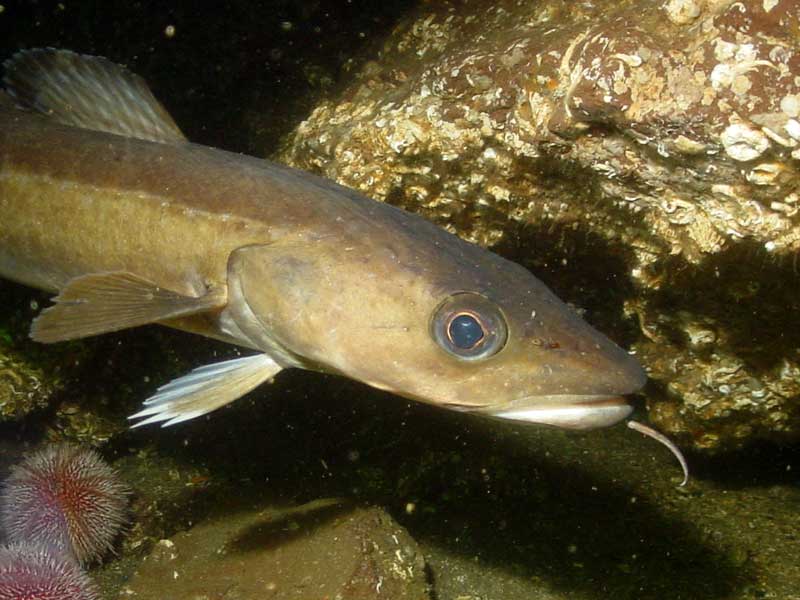Ling (Molva molva)
Distribution data supplied by the Ocean Biodiversity Information System (OBIS). To interrogate UK data visit the NBN Atlas.Map Help
| Researched by | Sonia Rowley | Refereed by | Admin |
| Authority | (Linnaeus, 1758) | ||
| Other common names | - | Synonyms | - |
Summary
Description
Recorded distribution in Britain and Ireland
Widely recorded around the British Isles, mainly off the south and west coasts of England, Ireland and the west Scotland.Global distribution
-Habitat
Molva molva is a deep water species found at depths up to 600 meters but juveniles and occasionally adults are found as shallow as 10 meters. This species is primarily solitary and benthic, lurking amongst rocks, crevices and wrecks in deep water.Depth range
-Identifying features
- Long thin fish up to 200 cm and 30 kg in weight.
- Two dorsal fins, the first one being short.
- Second dorsal and anal fins elongate.
- Upper jaw projects beyond the lower jaw which bears a sensory barbel.
- Marbelled greenish-brown dorsally with lighter flanks and underside.
- White edges to dorsal and anal fins.
Additional information
Spawning occurs offshore between March and August at a depth of 100-300 m. The females produce between 20-60 million pelagic eggs ca.1 mm in diameter. Each egg contains a single pale green oil globule, which enables them to stay in the upper layers of the water column to develop and eventually hatch after about 10 days. The fry of Molva molva have a downward faced head and the paired fins are both long (Dipper, 1984). Juvniles stay in coastal waters until the 2-3 years of age (Dipper, 2001; Wheeler, 1969). Growth is initially rapid: up to 20 cm long in the first year; 35 cm in the second; 55 cm in the third and up to 83 cm in the forth year. Subsequent annual growth is between 8-10 cm until the ninth year. Females invariably grow faster and live longer than males. Females reach maturity at 90-100 cm or 6-8 years of age and can live up to 14 years. Males reach maturity at ca. 80 cm and rarely live over 10 years of age (Wheeler, 1969).Molva molva primarily feeds on other fish such as Trisopterus esmarkii, Gadus gadus, Clupea harengus and flat fish, and invertebrates such as crustaceans and starfish may also be consumed, but more likely by the inshore juveniles. This species is commercially fished using longlines and trawls around western Scotland. It is salted and dried as klipfisk and then exported to southern Europe (Muus & Dahlstrom, 1974; Wheeler, 1969). Molva molva maybe mistaken for Merluccius merluccius, although this species does not have a barbel. There are two other Molva species: Molva dypterygia and Molva macrophthalma with the former present only in UK waters. Molva molva can be distinguished from Molva dypterygia by its barbel being longer than the eye, and by having 59 to 70 second dorsal fin rays, whereas Molva dypterygia has 69 to 83 rays (Muus & Dahlstrom, 1974).
Listed by
Bibliography
Bruce, J.R., Colman, J.S. & Jones, N.S., 1963. Marine fauna of the Isle of Man. Liverpool: Liverpool University Press.
Costello, M.J., Bouchet, P., Boxshall, G., Emblow, C. & Vanden Berghe, E., 2004. European Register of Marine Species [On-line]. http://www.marbef.org/data/erms.php,
Dipper, F., 2001. British sea fishes (2nd edn). Teddington: Underwater World Publications Ltd.
Dipper, R., & Powell. A., 1984. Field guide to the water life of Britain. London: Reader's Digest Association Limited.
Foster-Smith, J. (ed.), 2000. The marine fauna and flora of the Cullercoats District. Marine species records for the North East Coast of England. Sunderland: Penshaw Press, for the Dove Marine Laboratory, University of Newcastle upon Tyne.
Gibson, R., Hextall, B. & Rogers, A., 2001. Photographic guide to the sea and seashore life of Britain and north-west Europe. Oxford: Oxford University Press.
Howson, C.M. & Picton, B.E., 1997. The species directory of the marine fauna and flora of the British Isles and surrounding seas. Belfast: Ulster Museum. [Ulster Museum publication, no. 276.]
MBA (Marine Biological Association), 1957. Plymouth Marine Fauna. Plymouth: Marine Biological Association of the United Kingdom.
Muus, B.J. & Dahlstrom, P., 1974. Collins guide to the sea fishes of Britain and North-Western Europe. Wm Collins Sons & Co. Ltd: London.
Naylor, P., 2003. Great British Marine Animals. Plymouth: Sound Diving Publications.
Picton, B.E. & Costello, M.J., 1998. BioMar biotope viewer: a guide to marine habitats, fauna and flora of Britain and Ireland. [CD-ROM] Environmental Sciences Unit, Trinity College, Dublin.
Wheeler, A., 1969. The fishes of the British Isles and north-west Europe. London: Macmillan.
Whitehead, P.J.P., Bauchot, M.-L., Hureau, J.-C., Nielson, J. & Tortonese, E. 1986. Fishes of the North-eastern Atlantic and the Mediterranean. Vol. I, II & III. Paris: United Nations Educational, Scientific and Cultural Organisation (UNESCO).
Datasets
Centre for Environmental Data and Recording, 2018. Ulster Museum Marine Surveys of Northern Ireland Coastal Waters. Occurrence dataset https://www.nmni.com/CEDaR/CEDaR-Centre-for-Environmental-Data-and-Recording.aspx accessed via NBNAtlas.org on 2018-09-25.
Environmental Records Information Centre North East, 2018. ERIC NE Combined dataset to 2017. Occurrence dataset: http://www.ericnortheast.org.ukl accessed via NBNAtlas.org on 2018-09-38
Fenwick, 2018. Aphotomarine. Occurrence dataset http://www.aphotomarine.com/index.html Accessed via NBNAtlas.org on 2018-10-01
Isle of Wight Local Records Centre, 2017. IOW Natural History & Archaeological Society Marine Records. Occurrence dataset: https://doi.org/10.15468/7axhcw accessed via GBIF.org on 2018-09-27.
Merseyside BioBank., 2018. Merseyside BioBank (unverified). Occurrence dataset: https://doi.org/10.15468/iou2ld accessed via GBIF.org on 2018-10-01.
NBN (National Biodiversity Network) Atlas. Available from: https://www.nbnatlas.org.
North East Scotland Biological Records Centre, 2017. NE Scotland fish records 1800-2010. Occurrence dataset: https://doi.org/10.15468/kjrwnd accessed via GBIF.org on 2018-10-01.
OBIS (Ocean Biodiversity Information System), 2025. Global map of species distribution using gridded data. Available from: Ocean Biogeographic Information System. www.iobis.org. Accessed: 2025-07-22
Citation
This review can be cited as:
Last Updated: 03/07/2008



